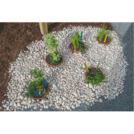
Students will determine a rule for classifying outdoor objects based on physicalproperties of matter.
- Subject:
- Physical Science
- Material Type:
- Lesson Plan
- Author:
- Out Teach
- Date Added:
- 07/22/2021

Students will determine a rule for classifying outdoor objects based on physicalproperties of matter.

This article assembles free resources from the Rocks and Minerals issue of the Beyond Penguins and Polar Bears cyberzine into a unit outline based on the 5E learning cycle framework. Outlines are provided for Grades K-2 and 3-5.
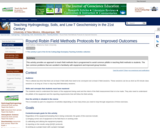
This activity provides an approach to teach field methods that is programmed to avoid common pitfalls in teaching field methods to students. The two common problems that are avoided is familiarity with equipment and improved group function.
(Note: this resource was added to OER Commons as part of a batch upload of over 2,200 records. If you notice an issue with the quality of the metadata, please let us know by using the 'report' button and we will flag it for consideration.)

This activity is a field-based investigation involving identifying and investigating common trees on the schoolyard and creating a field guide containing pressed leaves.

The Shallow and the Deep is a collection of lecture notes that offers an accessible introduction to neural networks and machine learning in general. However, it was clear from the beginning that these notes would not be able to cover this rapidly changing and growing field in its entirety. The focus lies on classical machine learning techniques, with a bias towards classification and regression. Other learning paradigms and many recent developments in, for instance, Deep Learning are not addressed or only briefly touched upon.
Biehl argues that having a solid knowledge of the foundations of the field is essential, especially for anyone who wants to explore the world of machine learning with an ambition that goes beyond the application of some software package to some data set. Therefore, The Shallow and the Deep places emphasis on fundamental concepts and theoretical background. This also involves delving into the history and pre-history of neural networks, where the foundations for most of the recent developments were laid. These notes aim to demystify machine learning and neural networks without losing the appreciation for their impressive power and versatility.
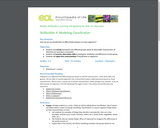
Students classify themselves into different groups based on observable characteristics of clothing and accessories, then apply to biological classification systems.
Educators Guide for this unit:
http://education.eol.org/lesson_plans/2-5_ScienceSkills_BioblitzSkillbuilderOverview.pdf
Lessons in this unit:
Biodiversity Skillbuilder 1: Meet a Creature
Biodiversity Skillbuilder 2: ID That Bird!
Biodiversity Skillbuilder 3: How Diverse is Biodiversity?
Biodiversity Skillbuilder 4: Modeling Classification
Biodiversity Skillbuilder 5: ID Using a Dichotomous Key
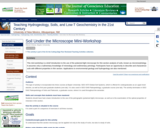
This mini-workshop is a brief introduction to the use of the polarized light microscope for thin-section analysis of soils, known as micromorphology. It assumes only a rudimentary knowledge of mineralogy and sedimentary petrology. Participants have an opportunity to describe and characterize soils with different properties in thin section. Applications to environmental geology and hydrogeology are also mentioned.
(Note: this resource was added to OER Commons as part of a batch upload of over 2,200 records. If you notice an issue with the quality of the metadata, please let us know by using the 'report' button and we will flag it for consideration.)
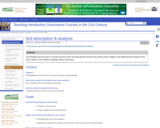
Students will have been through lectures on weathering & erosion, sediments and soils. Students go to the field and pull soil cores across a hill. They describe & measure the horizons, determine soil texture and structure. Using the data, they create a fence diagram and verbally describe what they see. Then they relate the changes in the soil profile downhill to climate, weathering, and the local geology. Students get to learn how to express information in multiple ways & make connections between "different" lecture topics, creating a continuity in the class.
(Note: this resource was added to OER Commons as part of a batch upload of over 2,200 records. If you notice an issue with the quality of the metadata, please let us know by using the 'report' button and we will flag it for consideration.)
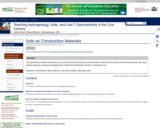
This geotechnical project will introduce you with the concept of using soils as construction materials.This project involves characterizing soils using various laboratory analyses and applying the Unified Soil Classification System in naming the soil.
Keywords: Geotechnical, Mass Wetness, Grain Size Analysis, Atterberg Limits
(Note: this resource was added to OER Commons as part of a batch upload of over 2,200 records. If you notice an issue with the quality of the metadata, please let us know by using the 'report' button and we will flag it for consideration.)
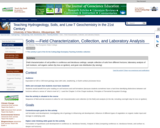
Field characterization of soil profiles in coniferous and deciduous settings; sample collection of soils from different horizons; laboratory analysis of soil moisture, soil organic carbon (by loss on ignition), and grain size distribution (by sieving)
(Note: this resource was added to OER Commons as part of a batch upload of over 2,200 records. If you notice an issue with the quality of the metadata, please let us know by using the 'report' button and we will flag it for consideration.)

Focuses on the problem of supervised learning from the perspective of modern statistical learning theory starting with the theory of multivariate function approximation from sparse data. Develops basic tools such as Regularization including Support Vector Machines for regression and classification. Derives generalization bounds using both stability and VC theory. Discusses topics such as boosting and feature selection. Examines applications in several areas: computer vision, computer graphics, text classification and bioinformatics. Final projects and hands-on applications and exercises are planned, paralleling the rapidly increasing practical uses of the techniques described in the subject.

This course is for upper-level graduate students who are planning careers in computational neuroscience. This course focuses on the problem of supervised learning from the perspective of modern statistical learning theory starting with the theory of multivariate function approximation from sparse data. It develops basic tools such as Regularization including Support Vector Machines for regression and classification. It derives generalization bounds using both stability and VC theory. It also discusses topics such as boosting and feature selection and examines applications in several areas: Computer Vision, Computer Graphics, Text Classification, and Bioinformatics. The final projects, hands-on applications, and exercises are designed to illustrate the rapidly increasing practical uses of the techniques described throughout the course.

At this stage of the "Lost in the Amazon" (hypothetical) adventure, students determine what supplies they will take with them to survive their trip through the Amazon. They use estimation and basic math skills to determine how much they can carry and what they can use to survive in the jungle environment as they travel on to their destination.
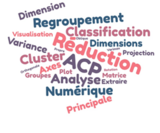
C'est une formation en ligne qui vise à aider les participants à réaliser une Analyse en composante Principale (ACP). Le niveau débutant de cette formation se compose de deux séquences. La séquence1 permet de découvrir les notions de base de l'ACP (principe, objectifs, avantages, inconénients,..). Le public cible: étudiants en master de recherche ou professionnel, doctorants, docteurs, enseignants, chercheurs, ingénieurs, médecins, autres.

This is the first in a series of modules that introduce species taxonomy. This module introduces Carolus Linnaeus' work.

The main aims of this seminar will be to go over the classification of surfaces (Enriques-Castelnuovo for characteristic zero, Bombieri-Mumford for characteristic p), while working out plenty of examples, and treating their geometry and arithmetic as far as possible.

This resource is a video abstract of a research paper created by Research Square on behalf of its authors. It provides a synopsis that's easy to understand, and can be used to introduce the topics it covers to students, researchers, and the general public. The video's transcript is also provided in full, with a portion provided below for preview:
"Since the 1970s, 16S ribosomal RNA sequencing has been the primary means of identifying bacteria in environmental samples of unknown composition. Among the most powerful tools for this sequencing is the Quantitative Insights Into Microbial Ecology (QIIME) package whose newest release, QIIME 2, boasts one of the highest classification accuracies for simulated metagenomes from the human gut, ocean, and soil. But a recent study suggests that even more powerful tools are available namely Kraken 2 and Bracken. Compared with QIIM2, Kraken 2 and Bracken were up to 100 times faster in generating the well-known Greengenes and SILVA 16S rRNA databases and up to 300 times faster at classification while using 100 times less RAM. Overall, Kraken 2 and Bracken produced more accurate 16S rRNA profiling results than QIIME2. Extremely fast, efficient, and accurate, Kraken 2 and Bracken could provide robust solutions for identifying and classifying bacterial species from a variety of environmental samples..."
The rest of the transcript, along with a link to the research itself, is available on the resource itself.

The basic objective of Unified Engineering is to give a solid understanding of the fundamental disciplines of aerospace engineering, as well as their interrelationships and applications. These disciplines are Materials and Structures (M); Computers and Programming (C); Fluid Mechanics (F); Thermodynamics (T); Propulsion (P); and Signals and Systems (S). In choosing to teach these subjects in a unified manner, the instructors seek to explain the common intellectual threads in these disciplines, as well as their combined application to solve engineering Systems Problems (SP). Throughout the year, the instructors emphasize the connections among the disciplines.
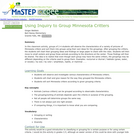
This activity is a teacher-guided inquiry activity of the sorting or grouping of Minnesota critters according to student driven criteria or purpose of their groupings. Teacher/student questions and discussion should be encouraged after this activity to emphasize that awareness of the criteria or purpose of certain groupings may be important before beginning an investigation.
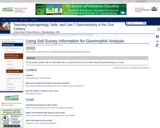
In this activity students will use information from a county-level soil survey to learn about the geomorphology of an area.
(Note: this resource was added to OER Commons as part of a batch upload of over 2,200 records. If you notice an issue with the quality of the metadata, please let us know by using the 'report' button and we will flag it for consideration.)